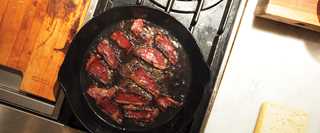Duck Bacon
Like traditional bacon, this unique recipe is hard to resist
Like traditional bacon, this unique recipe is hard to resist
There is a good reason many of us include bacon in our favorite waterfowl recipes. Ducks and geese are leaner than most domestic meats, so wrapping a mallard breast in bacon adds fat, salt, and flavor. You might not know that you can make bacon from duck breast fillets. Just imagine wrapping up your next duck popper with tasty strips of duck bacon. People won't stop talking about it.
Traditional bacon is made from the fattier parts of pigs. Before it is officially bacon, it must first be seasoned and cured. The curing process might sound scary, but it is just salt, sugar, and some form of cure, which includes sodium nitrite and often sodium nitrate as well. Duck bacon is best made with fattier duck breast fillets that have been plucked, not skinned. If all that is available are skinless fillets, they will work fine, but the cooked bacon will be lean and crispy.
Besides inhibiting bacteria growth, cures containing sodium nitrite give meat a pinkish color. Bacon can be made without a curing agent, but the color of the meat will be grayish and the flavor more reminiscent of a pork chop than bacon. The two most common cures are pink curing salt (also known as Prague Powder #1 or Insta Cure #1) and Morton Tender Quick. Pink curing salt can be found online or at some butcher shops. Note that pink curing salt is not the same as Himalayan or Hawaiian pink salt, neither of which are cures. Tender Quick can be purchased online and in some grocery stores. It is usually found in the canning section, not on the shelves with other salts. The two cures are vastly different and not interchangeable, and both should be carefully measured along with all other ingredients. The following recipe is for pink curing salt only.
Duck bacon is simple to prepare in a smoker or oven. Once the short curing process is complete, it can be used much like any other bacon. Refrigerate for up to one week. For longer storage, wrap carefully and freeze for up to a year. Save this recipe for fattier puddle ducks, not divers or leaner ducks and geese. Mallards, pintails, gadwalls, and black ducks are all great for making bacon.
[Step 1] In a bowl, combine kosher salt with pink curing salt, brown sugar, peppercorns, and coffee grounds. Mix thoroughly.
[Step 2] Using a fork, perforate only the skin (not the meat) of each fillet a few times.
[Step 3] Rub the mixture into all surfaces of the meat. Place in a zip-top bag and refrigerate for 12 hours, turning the bag over every couple of hours.
[Step 4] Remove fillets from the bag and rinse well with cold water. Pat dry. Arrange fillets on a rack with a pan underneath to catch any drippings and place in the refrigerator for two to three hours to air dry.
[Step 5] Smoke at low temperature (under 150 degrees) or bake in a 200-degree oven with the door open about 1/2 inch (use a ball of foil to keep the door ajar) for one hour. Cool completely.
[Step 6] Slice fillets into thin strips and fry as you would other bacon. To make slicing easier, place the fillets in the freezer for an hour or so before slicing.
Use duck bacon as you would conventional pork bacon.

Ducks Unlimited uses cookies to enhance your browsing experience, optimize site functionality, analyze traffic, and deliver personalized advertising through third parties. By continuing to use this site, you agree to our use of cookies. View Privacy Policy